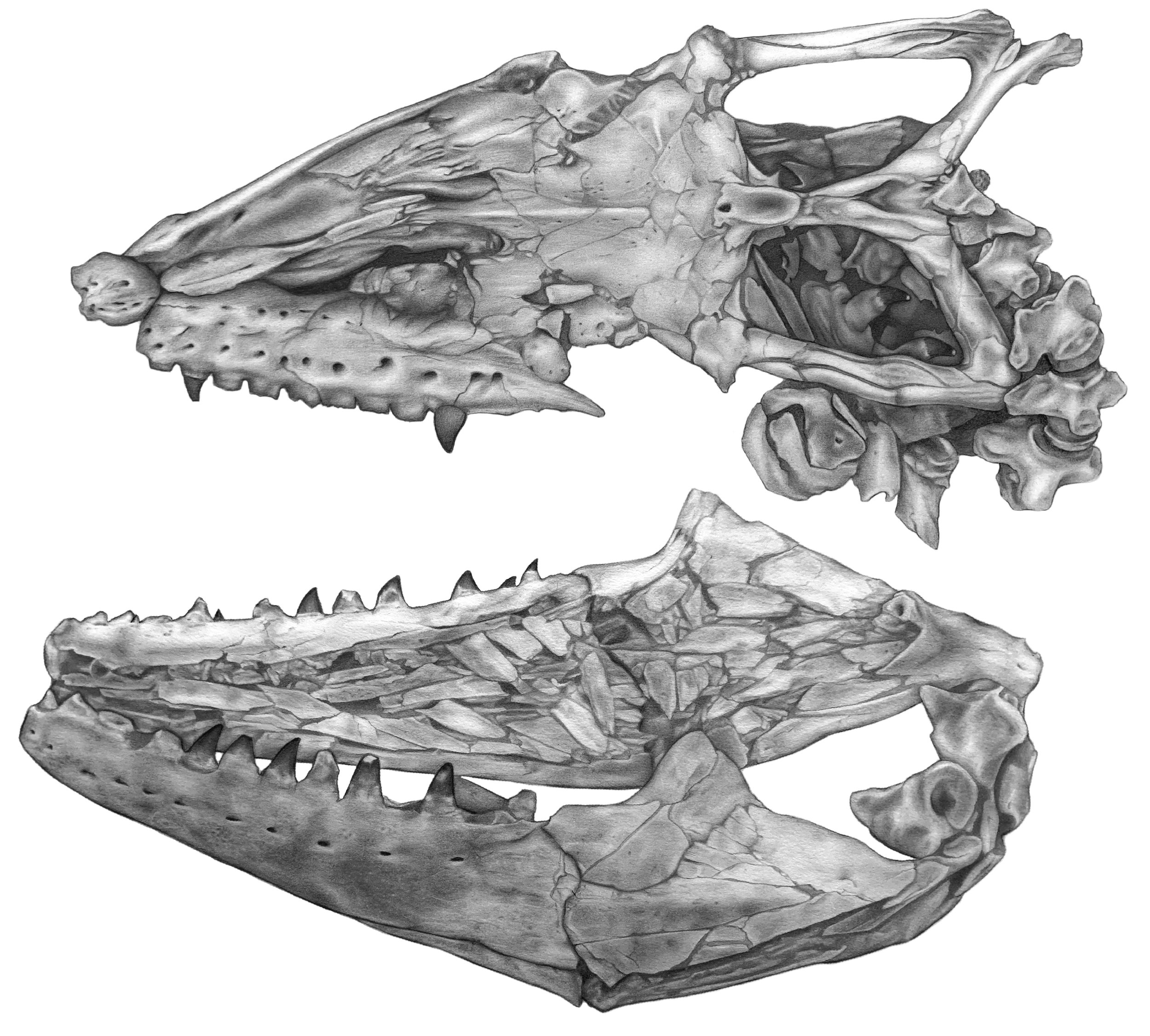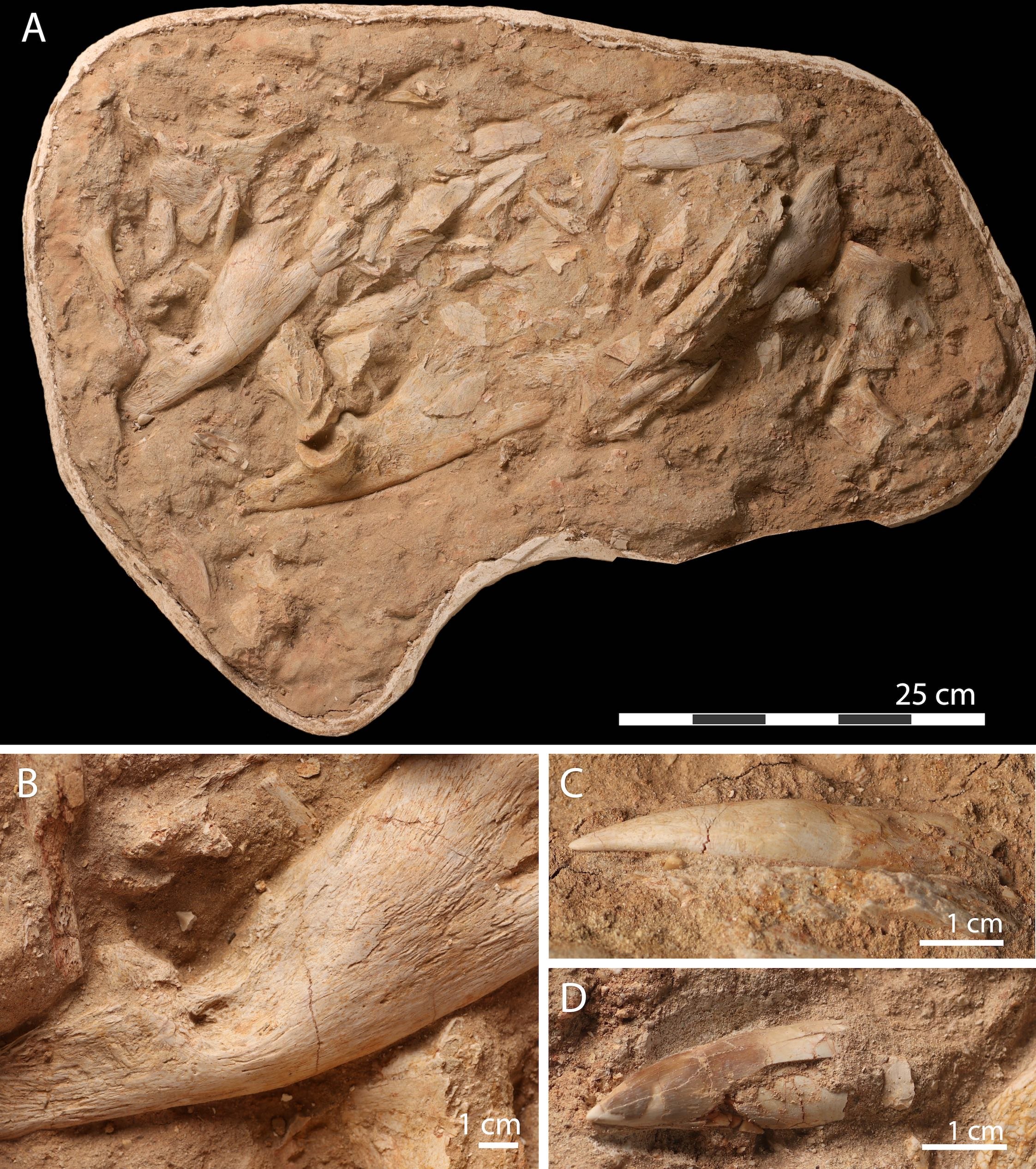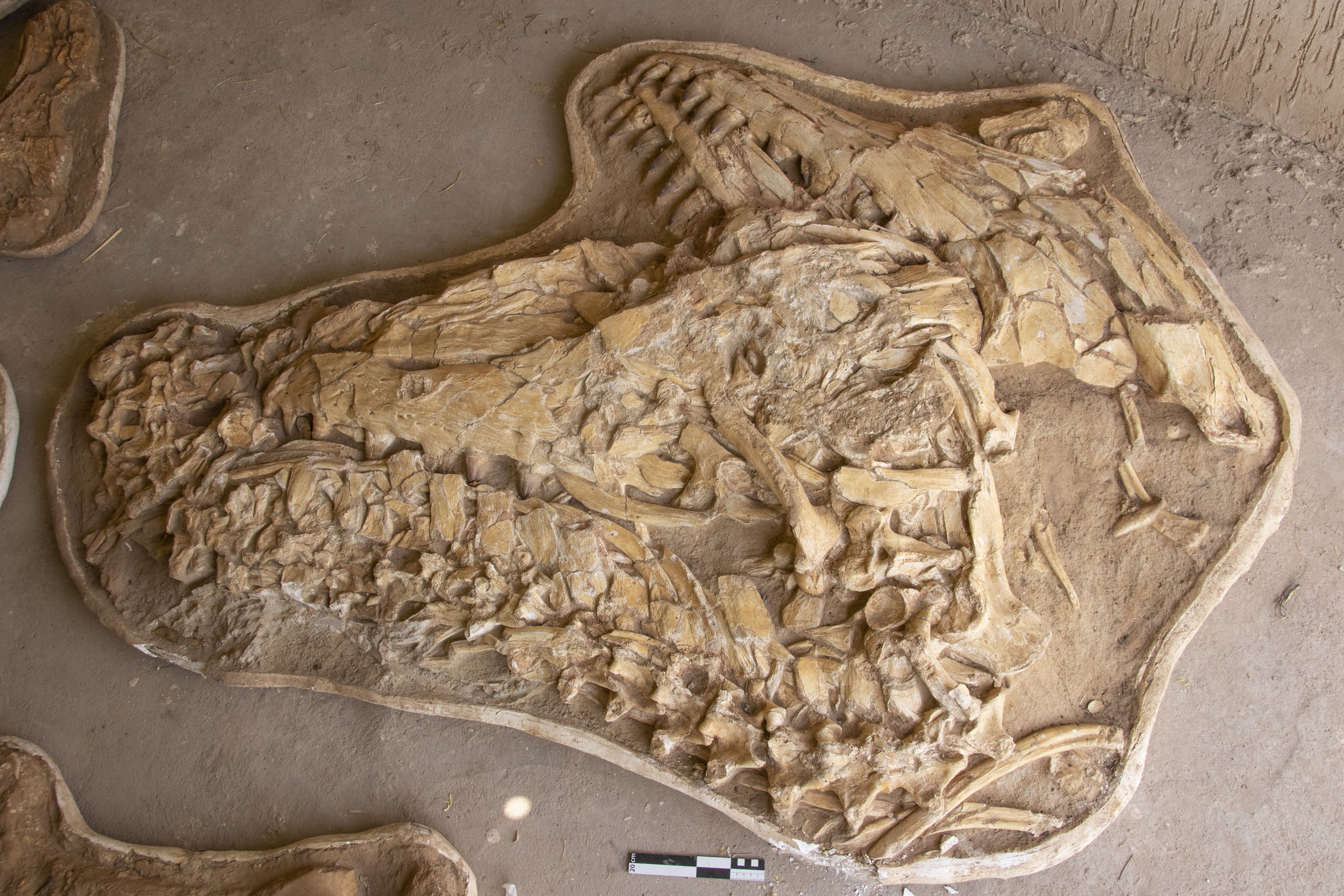Thalassotitan, the killer mosasaur
At the end of the Age of Dinosaurs, mosasaurs evolved into apex predators— the Cretaceous version of killer whales and white sharks
66 million years ago, sea monsters really existed.
They were mosasaurs, a family of giant marine reptiles. Mosasaurs weren’t dinosaurs, or even very closely related to them. Instead, they were a specialized family of aquatic lizards, relatives of iguanas, monitor lizards, and snakes. But mosasaurs left their terrestrial relatives behind, leaving the land to become highly adapted to an aquatic lifestyle. They were one of a handful of tetrapod groups to become fully specialized to a marine lifestyle, spending their whole lives at sea.
Mosasaurs looked rather like a Komodo dragon, except with paddle-like flippers in place of legs, and a shark-like tail fin used for propulsion. They also grew to enormous sizes. The biggest mosasaurs were about 40 feet (12 meters) in length. They were the largest lizards ever to evolve, and larger than many dinosaurs.
The origins of the mosasaurs go back to the middle of the Cretaceous, 100 million years ago. Their ancestors, the aigialosaurs, invaded the seas at this point, but were bit players, with ichthyosaurs and plesiosaurs dominating the sea. Then, around 94 million years ago, a volcanic eruption and greenhouse warming drove a major extinction, wiping out ichthyosaurs and giant plesiosaurs. Mosasaurs stepped in. They became much larger, and more specialized, evolving the ability to dive deep into the ocean, and evolving a remarkable range of skull and tooth shapes to prey on different animals.
Some mosasaurs had hook-like or spike-like teeth for seizing small prey like fish and squid. Others had blunt, crushing teeth and massive jaws from crushing clams, urchins, and ammonites. And finally, one group evolved jaws and teeth specialized for eating other marine reptiles- including other mosasaurs. They evolved a specialized killer-whale like morphology, which let them prey on even the biggest marine reptiles.
A juvenile Thalassotitan
The Mosasaurs of Morocco
At the end of the Cretaceous, the sea levels were much higher than they are today, and much of Africa was covered in shallow seas. Morocco was inundated by the Atlantic, with a warm, shallow waters extending to the Atlas Mountains. The trade winds blew to the west, pulling surface water to the west, and drawing nutrient rich waters up from the bottom. This fed plankton, which fed small fish, which fed larger fish, and so on, up to mosasaurs. Morocco’s mosasaur fauna is the most diverse in the world.
Xenodens calminechari, described 2021
And as diverse as it is, we keep finding more and more mosasaurs, things like Xenodens and Pluridens serpentis. It’s possible around 20 to 25, or even 30 species existed here. That might sound like a lot, but consider that there are 26 cetaceans living off the coast of Morocco today.
Why not a similar number of mosasaurs?
Pluridens serpentis, another new mosasaur from Morocco, also described 2021
Thalassotitan atrox is yet another new mosasaur from Morocco. It’s very similar to Prognathodon saturator from the Netherlands, but with a distinct frontal shape, and slightly more robust teeth.
Thalassotitan atrox paratype
The skull on these things is highly specialized compared to other mosasaurs. In contrast to the fairly long, slender snout and spike-like teeth seen in Mosasaurus, you have a very short, broad snout and robust jaws, similar to a killer whale. The teeth are especially killer-whale like, being short, fat cones, well adapted for seizing and tearing apart large prey.
A juvenile Thalassotitan from Sidi Chennane, showing the short, conical teeth.
The Better to Eat You With
Mosasaurs were already well-adapted for eating large prey. Their lower jaws were hinged, allowing the mandible to bend outward and swallow prey wider than the head. These specializations suggest that Thalassotitan was probably taking things too large to be swallowed whole- like a killer whale, it would seize large prey and tear it apart, then swallow the pieces.
This might seem speculative, but we have good evidence that Thalassotitan was doing something very different from most other mosasaurs in terms of feeding. For one, tooth wear.
Heavy tooth wear in a small Thalassotitan.
Almost all Thalassotitan specimens show tooth wear- heavy tooth wear. Apices are blunted, worn, chipped, broken, ground down. This animal had terrible dental hygiene.
This isn’t the kind of thing you’d expect in a fish eater. Fish are actually pretty hard on teeth- bony scales, and the flesh is full of small bones. But speaking fish eaters don’t show this level of wear and breakage. Instead, this kind of tooth damage is suggestive of biting into hard bone, eating other reptiles- sea turtles in particular.
The Remains of the Prey
The other evidence we have consists of potential prey.
The phosphates are unusual in having a number of fossils that show acid damage. It’s common to find mosasaurs and large fish in which the tooth enamel is damaged. The shiny enamel is gone, the tooth crown is eaten away.
Acid-damaged teeth of Halisaurus arambourgi
Digested mosasaurs. (A), Eremiasaurus heterodon, (B), Gavialomimus almaghrebensis, (C) Halisaurus arambourgi, (D) Halisaurus arambourgi
And we see this for lots of animals- at least three different taxa of mosasaurs. Some of them pretty large- we have a 60-cm long Eremiasaurus jaw with the teeth digested; that’s a 4-meter long mosasaur. Other taxa show similar things.
We have a couple of Enchodus jaws that have the enamel stripped away. This is actually pretty common. But what’s bizarre is that they’re sitting directly atop a turtle and some broken up turtle bones. What this seems to represent is a fish that was eaten by a mosasaur, along with a sea turtle- and then the bones of both animals were spat up together. So we have evidence of these mosasaurs preying on both very large fish, and sea turtles.
But perhaps the most impressive specimen consists of the head of a large elasmosaur- the skull is about 50 cm long. The jaws are preserved with some neck vertebrae. and the teeth have the enamel partially or entirely stripped off. The head of this plesiosaur was bitten off, swallowed, digested, and then spat up.
Can we prove that these animals were eaten by Thalassotitan? Well, we can’t know for certain. But it’s certainly suggestive.
We have marine reptiles that have been eaten by a large predator.
And we have a giant mosasaur whose anatomy and tooth wear both suggest it’s a top predator, preying on other marine reptiles. And nothing else in the fauna really fits that profile. It’s a pretty good bet that Thalassotitan is the killer.
Maastrichtian Mosasaur Diversity and the K-PG extinction
So what does this all mean?
Well, for one thing it emphasizes just how diverse the mosasaurs were. In the 25 million years before the asteroid struck, they just kept getting more diverse.
More specialized.
Bigger.
There’s been lots of debate about whether diversity was declining and the environment under stress before the end-Cretaceous asteroid impact, and whether that contributed to the extinction at the K-Pg boundary. Mosasaurs suggest the environment wasn’t deteriorating- they were thriving up until the point the asteroid hit. This is a group going out in a blaze of glory, not fading away. And I think mosasaurs- being predators- can serve as a proxy for the overall diversity of the marine ecosystem. They’re able to get more diverse because the marine fauna as a whole is getting more diverse. This has implications for understanding mass extinctions.
“Everything Happens for a Reason” versus “S***” Happens”
What does all this mean for understanding the end-Cretaceous mass extinction? Well, there’s been this long-running debate about the dynamics of the end-Cretaceous mass extinction. One scenario invokes gradual changes leading up the end-Cretaceous mass extinction as driving diversity down, leaving the fauna vulnerable to disruption. Maybe even the asteroid is just the final blow.
In this scenario, the extinction is, at least to a degree, the predictable outcome of slow, gradual processes, which fits nicely with Darwin’s ideas about how evolution works. It’s somewhat deterministic, predictable.
“Everything Happens for a Reason.”
The other scenario says that ecosystems were doing just fine before the extinction- or even increasing in diversity (which is what I think Thalassotitan and the other mosasaurs are showing). Right up until the asteroid hit and wiped mosasaurs and everything else out. In this scenario, we have a highly diverse, functional ecosystem that was literally in a matter of weeks and months destroyed by a single, catastrophic, completely unpredictable event.
This perspective on evolution is terrifying.
We’d like to think there’s some order and predictability to life. This second scenario suggests that, no, it’s not predictable. There’s no order. Everything could be going well and you could be wiped off the face of the earth entirely, as if you’d been struck by lightning out of the blue (or hit by an asteroid).
“S*** Happens”.
The patterns we see in mosasaurs, I think, support this second, “S***Happens” view of evolution.
I’m not saying I like this, mind you. Far from it.
I vastly prefer the idea that evolution has some predictability. It implies our lives do too. If we make the right choices, things will tend to work out well. If we make bad choices, things end badly. Our outcomes are contingent upon, and result from our choices in a logical way. It’s a very satisfying view of life, it implies we have control, and that moreover, at some level we get what we deserve. Be good, get a gold star.
In stories, things happen for a reason. Oscar Wilde once said of fiction that “the good end happily, the bad unhappily, that is why it is called fiction”. We like our stories to have meaning. The same is true when we discuss stories about the past. That isn’t necessarily how life works.
The idea that things happen randomly is unnerving and terrifying. I think as much as anything that’s why people resisted the idea of a catastrophic mass extinction for so long.
Do Mosasaurs Mirror Dinosaurs (or Vice Versa)?
Another thing that’s striking here is the parallel with dinosaurs. Mosasaurs seem to be mirroring the dynamics of dinosaur evolution in the latest Cretaceous, not just in their catastrophic extinction, but also in the diversification leading up to it.
At the same time mosasaurs were evolving into these giant apex predators, the tyrannosaurs were doing the same thing in North America and Asia. And in the southern continents, another group, the Abelisauridae, move into the top predator niche at the same time. Likewise other dinosaurs got big- hadrosaurs and ceratopsians- when the mosasaurs did.
Is this all just a coincidence?
Maybe. But the origin story of mosasaurs has some striking parallels to tyrannosaurs. Following the extinction of giant pliosaurid plesiosaurs at the end of the Cenomanian, the little mosasaurs that appeared in the Turonian rapidly became much larger , eventually becoming apex predators.
Likewise, the extinction of giant allosauroids in the Cenomanian allowed the tiny tyrannosaurs found in the Turonian of North America to evolve into the huge T. rex over the next 25 million years. There’s a remarkable parallel between the evolutionary trajectory of mosasaurs and tyrannosaurs.
My suspicion is that the increase in diversity, niche occupation, and size of mosasaurs and dinosaurs near the end of the Cretaceous is due to a common cause- a mid-Cretaceous extinction. Specifically, it may be driven by extinctions across the Cenomanian-Turonian boundary around 95 million years ago, when volcanic eruptions wreaked havoc with the climate and drove runaway greenhouse warming. The evolution of the marine reptiles and the dinosaurs may follow the same course, driven by the same causes- and finally, sharing the same fate.
REFERENCES
Bardet, N., 2012. Maastrichtian marine reptiles of the Mediterranean Tethys: a palaeobiogeographical approach. Bulletin de la Société géologique de France 183, 573-596.
Bardet, N., Houssaye, A., Vincent, P., Pereda-Suberbiola, X., Amaghzaz, M., Jourani, E., Meslouh, S., 2015. Mosasaurids (Squamata) from the Maastrichtian phosphates of Morocco: biodiversity, palaeobiogeography and palaeoecology based on tooth morphoguilds. Gondwana Research 27, 1068-1078.
Bardet, N., Pereda-Suberbiola, X., Iarochène, M., Bouya, B., Amaghzaz, M., 2005. A new species of Halisaurus from the Late Cretaceous phosphates of Morocco, and the phylogenetical relationships of the Halisaurinae (Squamata: Mosasauridae). Zoological Journal of the Linnean Society 143, 447-472.
Bardet, N., Pereda-Suberbiola, X., Jouve, S., Bourdon, E., Vincent, P., Houssaye, A., Rage, J.-C., Jalil, N.-E., Bouya, B., Amaghzaz, M., 2010. Reptilian assemblages from the latest Cretaceous–Palaeogene phosphates of Morocco: from Arambourg to present time. Historical Biology 22, 186-199.
LeBlanc, A.R.H., Caldwell, M.W., Bardet, N., 2012. A new mosasaurine from the Maastrichtian (Upper Cretaceous) phosphates of Morocco and its implications for mosasaurine systematics. Journal of Vertebrate Paleontology 32, 82-104.
Longrich, N.R., 2016. A new species of Pluridens (Mosasauridae: Halisaurinae) from the upper Campanian of Southern Nigeria. Cretaceous Research 64, 36-44.
Longrich, N.R., Bardet, N., Schulp, A.S., Jalil, N.-E., 2021. Xenodens calminechari gen. et sp. nov., a bizarre mosasaurid (Mosasauridae, Squamata) with shark-like cutting teeth from the upper Maastrichtian of Morocco, North Africa. Cretaceous Research, 104764.
Longrich, N.R., Bardet, N., Khaldoune, F., Yazami, O.K., Jalil, N.-E., 2021. Pluridens serpentis, a new mosasaurid (Mosasauridae: Halisaurinae) from the Maastrichtian of Morocco and implications for mosasaur diversity. Cretaceous Research, 104882.
R.Longrich, N., Jalil, N.-E., Khaldoune, F., Yazami, O.K., Pereda-Suberbiola, X., Bardet, N., 2022. Thalassotitan atrox, a giant predatory mosasaurid (Squamata) from the Upper Maastrichtian Phosphates of Morocco. Cretaceous Research.
Martin, J.E., Vincent, P., Tacail, T., Khaldoune, F., Jourani, E., Bardet, N., Balter, V., 2017. Calcium isotopic evidence for vulnerable marine ecosystem structure prior to the K/Pg extinction. Current Biology 27, 1641-1644. e1642.
Schulp, A.S., Bardet, N., Bouya, B., 2009. A new species of the durophagous mosasaur Carinodens (Squamata, Mosasauridae) and additional material of Carinodens belgicus from the Maastrichtian phosphates of Morocco. Netherlands Journal of Geosciences 88, 161-167.
Schulte, P., Alegret, L., Arenillas, I., Arz, J.A., Barton, P.J., Bown, P.R., Bralower, T.J., Christeson, G.L., Claeys, P., Cockell, C.S., Collins, G.S., Deutsch, A., Goldin, T.J., Goto, K., Grajales-Nishimura, J.M., Grieve, R.A.F., Gulick, S.P.S., Johnson, K.R., Kiessling, W., Koeberl, C., Kring, D.A., MacLeod, K.G., Matsui, T., Melosh, J., Montanari, A., Morgan, J.V., Neal, C.R., Nicholas, D.J., Norris, R.D., Pierazzo, E., Ravizza, G., Vieyra, R., Reimold, W.U., Robin, E., Salge, T., Speijer, R.P., Sweet, A.R., Urrutia-Fucugauchi, J., Vajda, V., Whalen, M.T., Willumsen, P.S., 2010. The Chicxulub Asteroid Impact and Mass Extinction at the Cretaceous-Paleogene Boundary. Science 327, 1214-1218.
Strong, C.R., Caldwell, M.W., Konishi, T., Palci, A., 2020. A new species of longirostrine plioplatecarpine mosasaur (Squamata: Mosasauridae) from the Late Cretaceous of Morocco, with a re-evaluation of the problematic taxon ‘Platecarpus’ ptychodon. Journal of Systematic Palaeontology, 1-36.
Yans, J., Amaghzaz, M.B., Bouya, B., Cappetta, H., Iacumin, P., Kocsis, L., Mouflih, M., Selloum, O., Sen, S., Storme, J.-Y., 2014. First carbon isotope chemostratigraphy of the Ouled Abdoun phosphate Basin, Morocco; implications for dating and evolution of earliest African placental mammals. Gondwana Research 25, 257-269.














